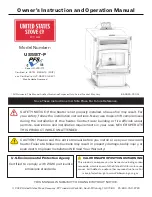
14
4.5 Fume exhaust duct
4.5.1 General notes
CAUTION: the pellet stove is not like other stoves. Fume draft is forced thanks to a fan that maintains
the pressure in the combustion chamber and slight pressure around the exhaust duct. Therefore, you
must verify that the latter is completely watertight and properly installed, both from the point of view
of function and safety.
Construction of the exhaust duct must be done by specialised personnel or companies, as reported in the
following manual. Always create the exhaust system so that periodic cleaning is assured without having to
dismantle any parts.
Tubes must
ALWAYS
be sealed with silicone (
no cementing
) that maintains resistance and elasticity
characteristics at high temperature (250°C) and are to be secured with a Ø3.9mm self-tapping screw.
•
The installation of dampers or valves which may obstruct the passage of exhaust fumes
is prohibited.
•
Installation in a chimney flue where exhausted fumes or vapours from other equipment (boilers, hoods,
etc.)
is prohibited
.
4.5.2 Tubes and maximum usable lengths
Painted aluminised steel tubes (minimum thickness 1.5 mm), stainless steel tubes (Aisi 316) or porcelain
tubes (minimum thickness 0.5 mm) with a nominal diameter of
80 mm
or
100 mm
(for tubes inside the
chimney flue max 150 mm) can be used.
Flexible hoses are permitted if they fall within the limits prescribed by law (in stainless steel with smooth inner
wall). The male-female connection collars must be at least 50 mm long.
Tube diameter depends on the type of system. The stove has been designed for Ø 80 mm and Ø 100 mm
tubes (check the technical data sheet of the selected model). As can be seen in the table below, a double-
wall Ø 100 mm tube may be necessary in some cases and models.
TYPE OF SYSTEM
WITH Ø 80 mm
TUBE
WITH DOUBLE-WALL Ø
100 mm TUBE
Minimum length
1.5 m
2m
Maximum length (with 3 90° curves)
4.5 m
8m
For installations situated over 1200 m above sea level
-
mandatory
Maximum number of curves
3
4
Horizontal sections with min. 5% incline
2m
2m
NOTE: load losses of a 90° curve can be equated with those of 1 metre of tube; the serviceable T-
connection is to be considered as a 90° curve.
Fig.9
Fig. 10















































